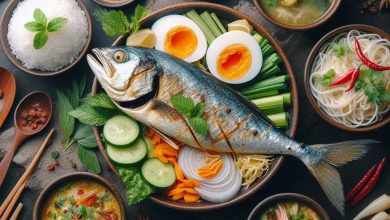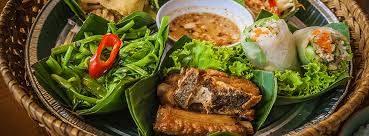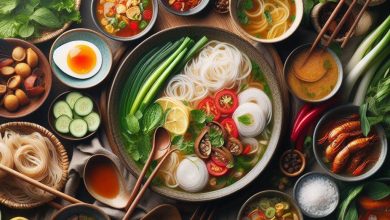Cambodian breakfasts cuisine, dishes,

The cuisine of Cambodia is both similar and different from the traditions of neighboring Asian countries. Lotus stalks, bamboo shoots, fried insects, snakes, bird embryos, shellfish, crops, as well as many greens, vegetables and fruits – a real paradise for lovers of exotic cuisine.
A distinctive feature of the local cuisine is that all dishes are prepared from fresh products, and cooked food is not stored in the refrigerator, but is eaten before the end of the day. In addition, Khmer cuisine is characterized by cooking on an open fire different types of meat, including seafood. The French influence is noticeable in the excellent buns that are already baked by early morning in small bakeries, usually scattered throughout the village.
Cambodian cuisine is not at all spicy, unlike Thai cuisine, but rather fragrant and savory, with extensive use of various herbs, seasonings and sauces. A very popular sauce is prahok: a thick, fermented fish paste known to the Khmer for over a thousand years is like butter or cheese to Europeans. Also popular is the sauce with black Kampot pepper, which is rightfully considered the best pepper in the world and gives dishes a special taste. To the surprise of foreigners, hemp is used as a seasoning for some dishes.
Rice, of course, is the head of everything. In Khmer, rice and food mean the same thing. Cambodians eat rice with every meal. It is served fried, boiled or as rice noodles. Cambodians even use rice in their desserts. They combine it with fruit or coconut milk and shavings to create a sweet treat like Raffaello.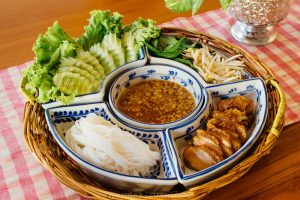
Rice in Cambodia is traditionally processed “roughly”, and it retains much more minerals and vitamins than standard rice in the same Thailand. Khmers enjoy eating vegetables and fruits green, including mango, tomato, guava, melon and many others. In local markets, red tomatoes are cheaper than green ones, as they are considered spoiled. Although potatoes are present in Cambodian cuisine, they are very rare.
As a drink, the Khmers are happy to drink sugar cane juice, as well as coconut water. Almost all drinks are served with ice. Green tea is served in any local cafe, it is not even included in the bill. In some cafes, you can find incredibly delicious local or Vietnamese coffee, prepared in the traditional way, although in most cases I use cheap varieties for making coffee. Milk and dairy products are not used for food at all due to the lack of dairy cows in the country.
Kampot: Durian
Campo’s fertile soil not only makes it a prime location for growing peppers, but also durians. Whether you like it or not, it’s a popular fruit in Southeast Asia and it’s quite expensive too.
Breakfast.
(Kiteu in Russian) is the most popular soup in Cambodia made of meat, glass or egg noodles, cooked in meat broth and seasoned with young rice sprouts, lime juice, sugar, chili pepper and fish sauce.
– with beef. The essence of the preparation of this soup is that they bring you a separate pot with broth, and separately raw vegetables, lotus shoots, boiled meat, giblets, entrails, seasonings and sauces.
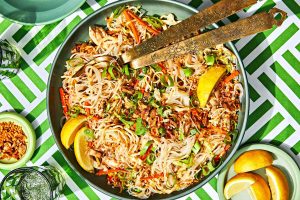
Soup you cook yourself, on a portable gas burner, which will be provided to you in every cafe. There are many Asian cafe chains in Cambodia that are called “SUKI SOUP”.
The name is not abusive and comes from China. And the ingredients travel in a large assortment, to your left, on a special conveyor.
From breakfast to dinner
A typical Cambodian breakfast is Bobor rice porridge, which is similar to Chinese congee. Another popular breakfast option is kuy teav, a soup of pork or beef bones and rice vermicelli topped with fried shallots, green onions and bean sprouts. And Bai sach chrouk, or pork with rice, is one of the simplest and tastiest Cambodian breakfast options.
A light snack is very popular with Cambodians at any time of the day. In the morning, vendors offer breakfast at small roadside stalls. Fresh cut fruit is sold before dinner. At the end of the day, spring rolls and beef barbecue, which is put in a baguette and sprinkled with chopped mango, are in great demand.
Rice is a staple food in Cambodia, and is a staple of every meal, both as an accompaniment and as an ingredient in many dishes.The geographic location of the wetlands (Cambodia has the second largest number of wetlands in Asia after Bangladesh) and will understand why water and therefore fish and rice (which grow in water) are an essential component of the cuisine. Many dishes, samlor in particular, are pond-like and often feature cane plants, leaves, and vegetables that reflect the surrounding landscape.
taste – and neighboring Vietnam, which it shares, share many common dishes, as well as colonial history, since both of them were part of the French colonial empire in southeast Asia.

